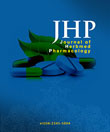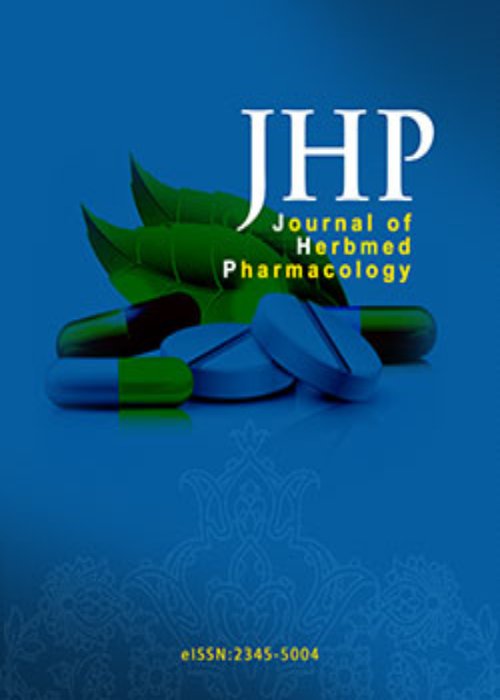فهرست مطالب

Journal of Herbmed Pharmacology
Volume:5 Issue: 3, Jul 2016
- تاریخ انتشار: 1395/05/06
- تعداد عناوین: 8
-
-
Pages 89-91Autism is a neurodevelopment disorder that causes disruption in communication, behavior and social interaction, and influences all aspects of child development. Families of autistic children are involved with it more than families of children with Down syndrome and mental disorders. The causes of Autism include psychosocial, immune, genetic and biological parameters. So far there is no effective drug treatment and rehabilitation for the treatment of autism. In this study, the most important medicinal plants with neuroprotective effects on autism have been reported. Based on the present study, medicinal herbs such as Zingiber officinale, Astragalus membranaceu, Ginkgo biloba, Centella asiatica, Acorus calamus, Paeonia lactiflora, Lobelia inflata and Actaea racemosa have neuroprotective effects and might be beneficial for this problem.Keywords: Autism, Herbs, Phytotherapy
-
Pages 92-98IntroductionMedicinal plants with phenolic compounds have been shown to have antimicrobial and antioxidant activities. The objective of the study was to evaluate the anti-ulcer effects of ethanolic extracts of Plumbaginales namely P. auriculata, P. indica and P. zeylanica and plumbagin in aspirin and ethanol induced gastric ulcer models.MethodsIn vivo studies including DPPH scavenging assay, lipid peroxidase inhibition assay, acid neutralizing capacity test, aspirin- and ethanol-induced ulcer models were performed to assess the antioxidant and antiulcer effects of plants. By using the models of Aspirin (200 mg/kg, 1 hour after the administration of last dose of the extract/ranitidine) and ethanol (1 mL/200 g, 90%) induced ulcer, animals were randomly divided into three groups of six animals each. Group I served as positive control, group II acted as standard and received ranitidine (20 mg/kg). The group III was treated with ethanolic extract by oral route in a dose of 300 mg/kg for a period of 5 days. The animals were sacrificed and the stomach was then excised and cut along the greater curvature, washed carefully with 5.0 mL of 0.9% NaCl and ulcers were scored.ResultsBoth the aspirin- and ethanol-induced models of ulcer with various extracts of Plumbaginales showed significant acid neutralizing and antioxidant properties.ConclusionThis study suggests that root extracts of P. auriculata may have good quality potentials for use in peptic ulcer diseases and that P. auriculata possesses an antiulcer effect.Keywords: Anti ulcer effects, P. zeylanica, P. indica, P. auriculata, Ulcer, induced model, Aspirin
-
Pages 99-102IntroductionCisplatin is one of the most potent chemotherapeutic antitumor drugs. Also, oxidative stress has been established to be involved in cisplatin-induced toxicity. Therefore, the present study was undertaken to examine the antioxidant and anti-inflammation potential of green tea hydroalcoholic extract (GTE) against the liver function of cisplatin in male rats.MethodsAdult male Wistar rats (180250 g) were divided into 4 groups (n = 5) treated as follows: (1) control group (saline solution, 1 ml kg−1 body weight, i.p.), cisplatin group (7 mg kg−1 body weight, i.p.). Animals of Groups III received only green tea extract (30 mg/kg/day, by gavage). Group IV was given green tea extract cisplatin once daily for 24 hours. Liver function was evidenced in the cisplatin group by the increased serum levels of alanine aminotransferase (ALT) and aspartate aminotransferase (AST). The mechanism of cisplatin induced liver function was considered as being decreased the total antioxidant power (TAP). Systemic inflammation was assessed by tumor necrosis factor-alpha (TNF-α) levels.ResultsA decrease in TAP level in cisplatin group was observed compared with control group. GTE administration decreased TNF-α and increased TAP compared to cisplatin group, but showed no significant differences between groups.ConclusionThe results suggested that green tea could ameliorate cisplatin liver function in rats through reduction of oxidative toxic stress and inflammation.Keywords: Cisplatin, Green tea, Liver function, Oxidative toxic stress, Inflammation
-
Pages 103-106IntroductionImmunological adjuvants derived from various synthetic micro-organisms or from medicinal plant products enhance specific immune responses against vaccine antigens. Immunological studies have already done pertaining to identify compounds from medicinal plant metabolites that are suitable for vaccine formulation. In this study, aqueous leave extracts of Butea frondosa were selected to evaluate their haemolytic activity and immunoadjuvant effects.MethodsFor this study, immunoadjuvant activity was investigated ex vivo in mice model based studies using splenocyte proliferation assay and also measured IgG titre in cell culture supernatant (using indirect ELISA). Swiss mice were immunized subcutaneously with specific protein antigen i.e. hepatitis B vaccine containing surface antigen (HBsAg, 20 μg/mL; 10 μl) on day 0 and collected the spleen cells on day 4 and proceeded for proliferation assay of variable doses of aqueous leaves extracts of Butea frondosa (0.530 mg/ml; 50 μl) along with hepatitis B surface antigen (HBsAg) (challenging dose; 20 μg/mL; 10 μl) and also estimated the antibody (IgG) titre in splenocyte cell culture supernatant including determination of its haemolytic activity in human whole blood samples.ResultsThe results demonstrated that aqueous leave extracts stimulated HBsAg population at lower doses (0.5 mg/mL) and also enhanced IgG titre as compared with control and HBsAg treated group. In addition, aqueous leaves extracts of Butea frondosa showed anti-HBsAg titre at higher doses and also showed slightly haemolytic effect in human whole blood.ConclusionThese results suggested that aqueous extract of Butea frondosa may represent viable candidate for effective vaccine adjuvants due to their higher immune response (with respect to IgG titre and proliferation assay) and lower or non-haemolytic effects.Keywords: Adjuvants_Butea frondosa_Hepatitis B vaccine_ELISA_Haemolytic
-
Pages 107-111IntroductionNatural substances have been used since ancient times for treatment of a range of diseases and have represented stimulatory effects on the function of innate immunity. The purposes of this study were to prepare β-glucan from S. cerevisiae and to assess the efficacy of purified β-glucan, Zataria multiflora (Z. multiflora) essential oil and their complex on phagocytosis in Balb/c mice.Methodsβ-glucan was purified during three stages including alkaline-acid treatment (S1), DEAE sephacel chromatography (S2) and con-A sepharose chromatography (S3). Z. multiflora essential oil was extracted by water-distillation using Clevenger-type apparatus. The chemical composition of Z. multiflora essential oil was analyzed by a GC/MS system. β-glucan (15 mg/kg), Z. multiflora essential oil (100 mg/kg) and their complex (the same doses) were injected into Balb/c mice intraperitoneally (IP). The blood samples were collected at days 4 and 7 after injection and phagocytic activity was assayed by chemiluminescence method.ResultsThe results showed that the ratios of mannan to β-glucan were 70.3 to 29.7 for S1, 71.9 to 28.1 for S2 and zero to 100 for S3 (purified β-glucan). The major components of Z. multiflora were carvacrol (61%) and thymol (25%). Phagocytosis index means exhibited significant increases at day 4 (246%, 165% and 367%) and day 7 (242%, 235% and 309%) in mice treated with purified β-glucan, Z. multiflora essence, and their complex when compared to control mice, respectively (PConclusionThe results suggest that the complex of β-glucan and Z. multiflora oil might be used to immunize individuals as prophylactic and/or therapeutic adjuvant in immunocompromised subjects.Keywords: Saccharomyces cerevisiae, ? glucan, Zataria multiflora, Essence, Phagocytosis
-
Pages 112-115IntroductionThis study was planned to search the antibacterial activities of the ethanol and Chloroform extracts of Berberis vulgaris asperma stem and their synergistic effects with ciprofloxacin against some gram-negative pathogenic bacteria.MethodsBroth micro-dilution method was used for determination of minimum inhibitory concentrations (MICs) of the extracts alone or in association with ciprofloxacin and Phenylalanine-Arginine β-Naphtylamide (PAβN) as a positive control and efflux pumps inhibitor (EPI).ResultsMIC determination indicated that the extracts from Berberis vulgaris asperma stem were able to inhibit the growth of all the studied bacteria within a concentration range of 3900 to 37500 μg/mL. Synergistic effects were noted between the extracts from Berberis vulgaris asperma stem extracts and ciprofloxacin on all tested bacteria except Acinetobacter bummani.ConclusionBerberis vulgaris asperma stem extracts act as an antibacterial agent and potentiate ciprofloxacin effects on examined pathogenic bacteria.Keywords: Antibacterial activities, Berberis vulgaris asperma, Gram, negative bacteria
-
Pages 116-119IntroductionOrganophosphorus (OPs) pesticides such as malathion intoxication has been shown to generate oxidative stress due to the production of free radicals and alteration of the antioxidant defense system. The aim of this study was to evaluate the effects of extracts from green tea (GT) hydroalcoholic extract on liver function.MethodsMale Wistar rats were separated into 4 groups of 8 rats each. Group I (control), group II was given GT (10 mg/kg/day). Animals of groups III received only malathion, group IV was given GT malathion. Animals received malathion 150 mg/kg by gavage and GT 30 mg/kg for 1 week through intraperitoneal injection. Twenty-four hours after treatment, blood samples were collected. Alanine aminotransferase (ALT), aspartate aminotransferase (AST) concentrations as well as biomarkers of oxidative stress such as lipid peroxidation (LPO), total antioxidant capacity (TAC) and total thiol groups (TTG) were measured.ResultsA decrease in ALT and AST levels in GT group were observed compared with the ones in control group. Also, the results showed that malathion could increase liver toxicity in rats through reduction of ALT and AST.ConclusionAmelioration of malathion toxicity through reduction of inflammation may suggest a prolonged therapeutic option against pesticides-induced hepatotoxicity.Keywords: Green tea, Malathion, ALT, AST, Oxidative toxic stress, Rat
-
Pages 120-124IntroductionMedicinal plants have been used to treat various immunological diseases. Nitric oxide (NO) including proliferation and CD14 monocyte surface marker has played an important regulatory role in various types of inflammatory processes. This study was aimed to evaluate or scrutinize the effect of flavonoid extracted from the leaves of Santalum album, Butea frondosa and Emblica officinalis for determining their anti-inflammatory and immunosuppressive activity on human peripheral blood mononuclear cells (PBMC) using hepatitis B vaccine antigen (20 μg/mL; 10 μl).MethodsFlavonoids extracted from these medicinal plants were prepared (0.510 mg/mL; 50 μl) and their effects on human PBMC proliferation were examined using HBsAg. The NO production including CD14 monocyte surface marker was also estimated.ResultsAll these flavonoids at higher doses demonstrated a significant decrease in proliferation, NO production and CD14 surface marker. This inhibitory effect was seen after 48 hours of treatment.ConclusionThese results may indicate the presence of anti-inflammatory and immunosuppressive activity in these medicinal plants.Keywords: Santalum album, Butea frondosa, Emblica officinalis, Anti, inflammatory, Immunosuppressive


